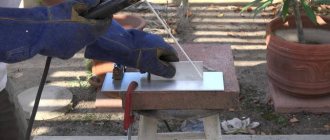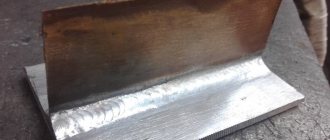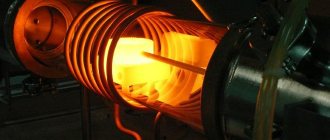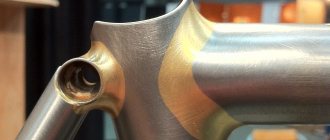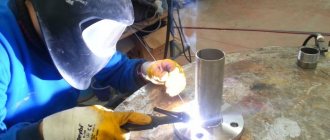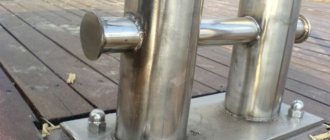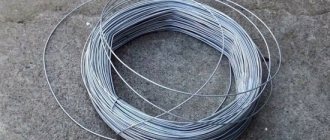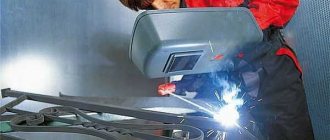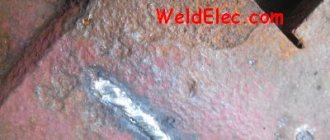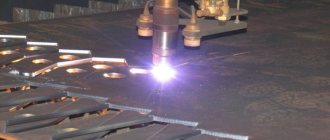The highest quality and most beautiful seams are obtained if stainless steel is joined by semi-automatic welding under argon protection. But not every home craftsman has the opportunity to purchase expensive equipment and gas. When the aesthetics of the connection is not important, the required quality is achieved by welding stainless steel with an inverter.
Advantages and disadvantages of welding stainless steel with an inverter
When comparing stainless steel welding with an inverter with other methods, the following advantages are noted:
- low price of the device;
- light weight and dimensions allow you to carry the inverter even in a bag;
- manual arc welding can be used to connect workpieces up to 20 mm thick from alloys, ferrous and non-ferrous metals;
- work is carried out without flux or inert gas;
- performing welding in hard-to-reach places.
Flaws:
- slag formation;
- due to the high electrical resistance of stainless steel, overheating of the electrode with destruction of the coating is possible, so the welding current is limited;
- more time consuming when compared to other methods.
Features of the technology
Due to the physical and chemical properties of stainless steel as a metal being welded, the most optimal method is welding using a non-consumable electrode in a shielding gas (argon or its mixture can be used as such a gas). In production, to achieve higher quality welded joints, combined welding methods are used, in which the root layer of the weld is performed using argon arc welding, and subsequent layers are performed using manual arc welding.
The selection of operating parameters of the welding inverter (welding current and welding voltage parameters) is based on the following data:
- thickness of welded parts;
- type and grade of steel;
- data on the operating mode of the product or connection;
- very high coefficient of thermal expansion of stainless steel parts - when heated, a significant “stretching” of the parts occurs, and when cooled, compression occurs, which can cause the formation of microcracks in the weld, as well as in the product itself in that part of it that belongs to the welding zone and exposed to heat;
- welding should be carried out with a minimal increase in metal temperature to avoid overheating of the heat-affected zone. If overheating above 500 degrees Celsius occurs, the process of intercrystalline corrosion will begin inside the metal, which will cause destruction of the weld and the entire part as a whole, having the most negative impact on the quality of the seam.
In each specific case, it is necessary to select modes individually, carrying out a mandatory test on parts similar to those being welded. The main condition for welding stainless steel parts is to reduce the welding current compared to other types of steel by at least 20%.
The features of welding technology should also include the mandatory selection of all tools so that they comply with the rules for working with stainless steel: grinder wheels, brushes used for stripping metal must be suitable for working with stainless steel, since in the case of using conventional tools they can metal inclusions may form in the weld, which negatively affects its quality.
Welding methods
There are three ways to weld stainless steel at home with an inverter:
- Manual arc welding (MMA), when the material of a consumable electrode is filled into the joint. To operate, you only need an inverter.
- The argon arc method (TIG) with a tungsten electrode is used for welding thin stainless steel with an inverter. The weld is created by melting the workpiece material or filler wire. The weld pool is protected from contact with ambient air by pure argon. Moving the burner with a non-consumable electrode and feeding the filler wire are performed manually.
- Semi-automatic welding (MIG/MAG) is performed with a non-consumable electrode with mechanical wire feed. By increasing the welding speed, productivity increases. To improve the wettability of the edges, 2% carbon dioxide is added to argon.
Which inverter is suitable for welding stainless steel
To weld stainless steel, an inverter welding machine of any brand is used. For working at home, the simplest model is chosen. Craftsmen even make homemade devices whose characteristics are not inferior to their factory counterparts. The inverter must have a manual welding mode (MMA) and current adjustment within the range of 20 - 200 A. For welding stainless steel, it is desirable to have the following options:
- “Force and Furious” mode, which allows you to briefly reduce the arc voltage while simultaneously increasing the current;
- PV (duration of continuous operation, indicated in the instructions) not less than 40%;
- the length of the cables is no more than 6 m, otherwise due to the large power loss they will become very hot;
- maintaining operability even with significant changes in voltage in the electrical network.
Note!
When choosing an inverter, you need to carefully read the instructions, since not all models can operate at low temperatures.
We cook thin steel
This is one of the most difficult methods, requiring knowledge and skills in equal measure. In addition to accurately selecting suitable consumables, it is necessary to set the correct voltage with the current reduced by approximately 20%. You can only work with short rods - no longer than 35 mm. Do not allow high heating temperatures, the upper limit is 500°C, in no case higher.
Operating principle of MMA welding.
Household welding of thin stainless steel sheets is carried out using an inverter machine with strict production rules:
- Under no circumstances should the temperature level exceed 150°C in the joint area and general heating of surfaces.
- Use only low current values, but at high speed.
- To prevent the formation of holes and overheating of the working area, place gaskets in the form of plates under the workpieces: in this way, excess heat will dissipate.
- If the metal sheets are thinner than 3 mm, there is no need to trim the edges. The gap between the surfaces in this case should be no more than 2 mm.
The following electrodes are designed for working with thin stainless steel:
- TsL-11 , a public favorite, produces a very corrosion-resistant weld even in unfavorable environmental conditions.
- OK 63.20 works well in liquid aggressive media at high temperatures.
Selecting Electrodes
To weld stainless steel with a direct current inverter, it is allowed to use electrodes with a base coating based on calcium and magnesium carbonates. Popular domestic brands include OZL-8 and TsL-11. They are inexpensive, but require experience to operate. The electrodes are prone to sticking and do not hold the arc well, but the seams are obtained with sufficient anti-corrosion characteristics.
The best results are obtained if you choose universal electrodes with rutile coating for your work. They weld common grades of stainless steel using direct and alternating current. The best electrodes are OK 67.60, which are produced by the Swedish company ESAB. They light easily, hold the arc stably, and reduce the amount of molten metal splashes. When working with rutile grades, even a beginner can create a strong seam.
When manual welding, it should be taken into account that the cooling slag begins to spontaneously rebound. Therefore, at this time you need to be located at a safe distance so that it cannot get into your eyes or exposed skin.
We cook stainless pipes
A very common type of work, which also has its own specific characteristics. Here, tips with basic or rutile coating are used; for coatings or coatings, see below. The current should be DC with reverse polarity.
Direct current is especially good when welding thin-walled pipes: the metal does not spatter, the process is quite simple, and the weld is of very high quality.
- Tungsten tips can also be used when working with steel pipes. Unlike others, they require direct current of straight polarity. Despite their high price, they provide serious operational advantages:
- high resistance of seams to oxidation;
- arc stability;
- high corrosion resistance of seams.
- OK 63.20 is the already mentioned consumable for liquid aggressive media.
Rotary joints for pipe welding.
Regardless of the selected electrodes, welding of stainless pipes consists of three technological stages:
- Treating surfaces with a metal brush to remove dirt. Pay special attention to joints and areas near them.
- The welding process itself with ignition of the electrode and arc.
- Quality control of the connection with preliminary slag beating.
The process of welding stainless steel with an inverter at home
Before welding stainless steel with an inverter at home, the workpieces to be joined are prepared in the following order:
- Dirt and debris are removed from the surface near the joint and cleaned to a shine with sandpaper or a brush with metal bristles.
- The joint is treated with a solvent to remove grease. Otherwise, it will disrupt the stability of the arc.
- When connecting workpieces with a thickness of more than 4 mm, chamfers are removed from the edges at an angle of 45⁰ to better fill the joint with molten metal.
- To prevent splashes from sticking to adjacent surfaces, they are treated with an aqueous solution of chalk.
- To compensate for the thermal expansion of the workpieces being welded, a gap of 1 - 2 mm is left between them.
- Welding of stainless steel up to 1 mm thick is performed without a gap.
- To prevent overheating of the metal at the junction, the workpieces are placed on aluminum or copper plates.
- Parts thicker than 7 mm are preheated to 150⁰C to reduce the temperature difference at the beginning of welding.
- To remove moisture and improve the properties of the coating, the electrodes are calcined before use by placing them in an oven. In cases where the work is done urgently, heating with a gas burner is acceptable.
DC welding is carried out with reverse polarity. The connection is made with a short arc at a speed higher than for ordinary steel. The electrode is guided along the seam without transverse movements. It is tilted at an angle of 40 - 60⁰ to the side that is convenient for holding. Due to the high resistance to electric current and poor thermal conductivity of stainless steel, electrodes burn out faster than those on ferrous metals. This phenomenon comes as a surprise to novice craftsmen. The seam is completed with a “lock”, which will prevent the formation of cracks and fistulas. The weld pool is shifted to the surface of the workpiece or returned a little back. Without changing the position of the electrode, the arc is extinguished. Since it is not possible to weld thick stainless steel in one pass, the operation is repeated several times until the joint is completely filled.
After finishing welding, you should wait for the joint to cool down. Do not spray it with water, as this will lead to the appearance of microcracks. They begin to beat off the slag after 5 minutes so as not to leave marks on the still soft metal. To give a presentable appearance, the joint is ground and polished. However, as a result of mechanical processing, a passivated layer of chromium oxide is removed from the surface, which protects it from corrosion. The film is restored in 4 - 6 hours, during which the stainless steel remains unprotected. To speed up the process, the surface is treated with a composition containing passivating additives. After half an hour, it is washed off with water.
After reading the recommendations given, the answer to the question: “Is it possible to weld stainless steel with an inverter?” obvious. However, this does not mean that a beginner will be able to make a reliable connection the first time. To develop skills, you will have to practice on unnecessary scraps, preferably under the guidance of a mentor.
